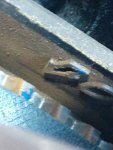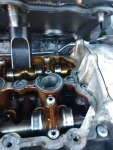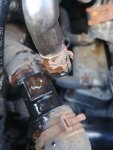For make benefit of the two people who are reading this thread, I give update. I decided to spring for a borescope. It's too important to wait for a sale. I got one of the supposedly nicer ones, a Depstech 5.0MP with 3rd generation processor, because the difference in price between the nice borescopes (~$40) and the cheapest is only about $20. Well... it turns out you still need to hold your hand supersteady while taking pics.
I also spaced out and put the cylinders at TDC when I really should have put them at BDC to inspect the cylinder walls. I had a difficult time removing even the upper timing cover. However, it is possible to flex it back far enough to see the arrow on the back point to the notch in the gear. Someone was also nice enough to put a blue dot on that tooth for me.

Why did they get rid of the inspection window after mid 2006?
I had to eyeball 180 degrees worth of manually cranking the crank pulley between cylinders. In any case, the cylinder heads don't appear to be cracked nor even show impact damage. Ironically, the one cylinder that shows some scratch marks is the only one that still shows good compression. Here they are in firing order: 1,3,4,2:




The shiny spot in cylinder 3 is most likely the capful of oil I drizzled down into the chamber for the wet compression test.
I envisioned either using the 45-degree mirror attachment or folding the borecope wire back on itself to check for valve damage. But the attachment wasn't adequate to the task. I had a surprising amount of difficulty just getting the scope down through the spark plug hole, I was fairly certain I'd get the camera stuck in there if I tried to fold the wire. So it looks like removing the cylinder head will be my best option for inspection. And that will take an entire day.
I did inspect the camshafts. Both are intact. At TDC, the lobes at #4 are mirror images of eachother as they should be.

I (eventually) removed the camchain cover. Holy cow. Nobody warns you just what a PITA it is to take that off. To even get to it, you need to remove the hpfp (if you're wondering, my follower looked fine) and brake booster vacuum. Every. Single. Screw is blocked by something. I ended up using a 4mm allen key to remove them Yes, I dropped the key in the middle of the job and had to go out and buy another one. There are 8 screws. Naturally I missed one before herniating myself trying to get the cover off.
There is also a coolant hardline in the way. You need to remove the hose clamps on either side of this hardline, then remove the heatshield for the turbo with the coolant line attached to it. Charles (aka The Humblemechanic) warns people on his hpfp video not to even LOOK at the coolant return flange. Yup. I broke mine.

As Han Solo would say, I didn't even hit it that hard. I temporarily stabilized it by jamming a body fastener into the hole. I did manage to get my mits on the Bentley, Chilton, AND Haynes guides (though it seems the Chilton and Haynes are exactly the same except with a different font). For all its thickness, the Bentley isn't necessarily better than the Haynes or Chilton guides. Half the Bentley is comprised of wiring diagrams and a complete printout of every single DTC possible. Both the Haynes and Chilton summarize removal of the camshaft chain cover with a single sentence:
Step 8. Remove fasteners from timing cover.
Nice.
So here was my reward for all that hard work:

Nothing obviously wrong. Chain is intact. I push down on the tensioner. It resists me. I turn the crank pully and the camshaft chain moves. The tensioner on the timing belt side is also fine. Timing belt is taught. But isn't there supposed to be at least one colored chainlink on the camshaft chain? I am unable to determine if it is in correct time.
So that's where I'm at right now. I assume I have valve damage and that I can attempt to do either a valve job or a head swap. It bothers me that I still don't have a handle on WHY the damage happened. Without this knowledge, I worry that I can spend $60 or $600 or $6000 trying to repair this only to have it break exactly the same way another 2 miles down the road.
I think what I'm going to do is have the car towed to my parents' place. That's just about the only place I can work on the vehicle in a covered garage off and on over the course of weeks or months if necessary. I'm going to treat this as a junkyard salvage project because that's kind of what it is at this point








